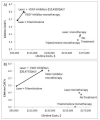Cost-effectiveness of treatment of diabetic macular edema
- PMID: 24573663
- PMCID: PMC4020006
- DOI: 10.7326/M13-0768
Cost-effectiveness of treatment of diabetic macular edema
Abstract
Background: Macular edema is the most common cause of vision loss among patients with diabetes.
Objective: To determine the cost-effectiveness of different treatments of diabetic macular edema (DME).
Design: Markov model.
Data sources: Published literature and expert opinion.
Target population: Patients with clinically significant DME.
Time horizon: Lifetime.
Perspective: Societal.
Intervention: Laser treatment, intraocular injections of triamcinolone or a vascular endothelial growth factor (VEGF) inhibitor, or a combination of both.
Outcome measures: Discounted costs, gains in quality-adjusted life-years (QALYs), and incremental cost-effectiveness ratios (ICERs).
Results of base-case analysis: All treatments except laser monotherapy substantially reduced costs, and all treatments except triamcinolone monotherapy increased QALYs. Laser treatment plus a VEGF inhibitor achieved the greatest benefit, gaining 0.56 QALYs at a cost of $6975 for an ICER of $12 410 per QALY compared with laser treatment plus triamcinolone. Monotherapy with a VEGF inhibitor achieved similar outcomes to combination therapy with laser treatment plus a VEGF inhibitor. Laser monotherapy and triamcinolone monotherapy were less effective and more costly than combination therapy.
Results of sensitivity analysis: VEGF inhibitor monotherapy was sometimes preferred over laser treatment plus a VEGF inhibitor, depending on the reduction in quality of life with loss of visual acuity. When the VEGF inhibitor bevacizumab was as effective as ranibizumab, it was preferable because of its lower cost.
Limitation: Long-term outcome data for treated and untreated diseases are limited.
Conclusion: The most effective treatment of DME is VEGF inhibitor injections with or without laser treatment. This therapy compares favorably with cost-effective interventions for other conditions.
Primary funding source: Agency for Healthcare Research and Quality.
Figures


Similar articles
-
Cost-effectiveness of Aflibercept, Bevacizumab, and Ranibizumab for Diabetic Macular Edema Treatment: Analysis From the Diabetic Retinopathy Clinical Research Network Comparative Effectiveness Trial.JAMA Ophthalmol. 2016 Aug 1;134(8):888-96. doi: 10.1001/jamaophthalmol.2016.1669. JAMA Ophthalmol. 2016. PMID: 27280850 Free PMC article. Clinical Trial.
-
Cost-effectiveness of various interventions for newly diagnosed diabetic macular edema.Ophthalmology. 2013 Sep;120(9):1835-42. doi: 10.1016/j.ophtha.2013.02.002. Epub 2013 May 1. Ophthalmology. 2013. PMID: 23642372 Free PMC article.
-
Cost-effectiveness analysis of ranibizumab plus prompt or deferred laser or triamcinolone plus prompt laser for diabetic macular edema.Ophthalmology. 2012 Aug;119(8):1679-84. doi: 10.1016/j.ophtha.2012.01.049. Epub 2012 Apr 13. Ophthalmology. 2012. PMID: 22503301 Free PMC article.
-
Anti-VEGF for the management of diabetic macular edema.J Immunol Res. 2014;2014:632307. doi: 10.1155/2014/632307. Epub 2014 Feb 5. J Immunol Res. 2014. PMID: 24741610 Free PMC article. Review.
-
Comparative effectiveness of anti-VEGF agents for diabetic macular edema.Int J Technol Assess Health Care. 2013 Oct;29(4):392-401. doi: 10.1017/S0266462313000500. Int J Technol Assess Health Care. 2013. PMID: 24290332 Review.
Cited by
-
Diabetic Macular Edema Management: A Review of Anti-Vascular Endothelial Growth Factor (VEGF) Therapies.Cureus. 2024 Jan 21;16(1):e52676. doi: 10.7759/cureus.52676. eCollection 2024 Jan. Cureus. 2024. PMID: 38264181 Free PMC article. Review.
-
Visual impairment and blindness in type 2 diabetics: Ife-Ijesa diabetic retinopathy study.Int Ophthalmol. 2016 Aug;36(4):477-85. doi: 10.1007/s10792-015-0145-8. Epub 2015 Nov 4. Int Ophthalmol. 2016. PMID: 26537878
-
Cost-effectiveness of Aflibercept, Bevacizumab, and Ranibizumab for Diabetic Macular Edema Treatment: Analysis From the Diabetic Retinopathy Clinical Research Network Comparative Effectiveness Trial.JAMA Ophthalmol. 2016 Aug 1;134(8):888-96. doi: 10.1001/jamaophthalmol.2016.1669. JAMA Ophthalmol. 2016. PMID: 27280850 Free PMC article. Clinical Trial.
-
Development and validation of a simple and practical model for early detection of diabetic macular edema in patients with type 2 diabetes mellitus using easily accessible systemic variables.J Transl Med. 2024 May 31;22(1):523. doi: 10.1186/s12967-024-05328-y. J Transl Med. 2024. PMID: 38822359 Free PMC article.
-
Quality-adjusted life years in macular oedema due to age-related macular degeneration, diabetes and central retinal vein occlusion: the impact of anti-VEGF agents in a tertiary centre in Greece.Int Ophthalmol. 2022 Sep;42(9):2673-2684. doi: 10.1007/s10792-022-02256-y. Epub 2022 Apr 13. Int Ophthalmol. 2022. PMID: 35416615
References
-
- Centers for Disease Control and Prevention . National Diabetes Fact Sheet: National Estimates and General Information on Diabetes and Prediabetes in the United States, 2011. Centers for Disease Control and Prevention; Atlanta, GA: Dec 8, 2011. Accessed at www.cdc.gov/diabetes/pubs/pdf/ndfs_2011.pdf. 2011.
-
- Williams R, Airey M, Baxter H, Forrester J, Kennedy-Martin T, Girach A. Epidemiology of diabetic retinopathy and macular oedema: a systematic review. Eye (Lond) 2004;18:963–83. [PMID: 15232600] - PubMed
-
- Klein R, Klein BE, Moss SE. The epidemiology of ocular problems in diabetes mellitus. In: Ferman SS, editor. Ocular Problems in Diabetes Mellitus. Blackwell Scientific; Boston: 1991. pp. 1–51.
Publication types
MeSH terms
Substances
Grants and funding
LinkOut - more resources
Full Text Sources
Other Literature Sources
Medical
Research Materials
